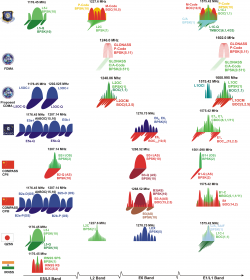If you wish to contribute or participate in the discussions about articles you are invited to contact the Editor
Galileo High Accuracy Service (HAS)
| GALILEO | |
|---|---|
| Title | Galileo High Accuracy Service (HAS) |
| Edited by | GMV |
| Level | Basic |
| Year of Publication | 2011 |
The GALILEO System is an independent, global, European-controlled, satellite-based navigation system and provides a number of services to users equipped with Galileo-compatible receivers.
Accurate to the nearest centimetre, the GALILEO High Accuracy Service (HAS) allows for development of applications for professional or commercial use owing to improved performance and data with greater added value than that obtained through the open service.[1] The Galileo High Accuracy Service results from the re-scope of the former Galileo Commercial Service (CS).
Purpose
The High Accuracy Service (HAS) is aimed at market applications requiring higher performance than offered by the Open Service. It provides added value services on a free charge basis, with content and format of data publicly and openly available on a global scale. Galileo HAS uses combination of two signals in E6 band: a data (E6-B) component, plus the reserved-1 fields in the Open Service I/NAV disseminated trough the E1-B. E6 signals are modulated with a binary phase shift keying BPSK(5) at a carrier frequency of 1278.75 MHz, which is used by all satellites and shared through a code division multiple access (CDMA) RF channel access method. Therefore, the signal main lobe and most of the signal power is in the 1273.75-1283.75 MHz band. This combination of E6 signals plus the bits in I/NAV message provides higher data throughput rate and higher accuracy authenticated data.
The foreseen applications will be based on: [2]
- Dissemination of data with a rate of 448 bps, for added value services;
- Broadcasting of one signal, separated in frequency from the Open Services signals in differential applications to facilitate advanced applications such as integration of Galileo positioning applications with wireless communications networks, high accuracy positioning and indoor navigation.
Developing commercial applications either by using the HAS signals alone, or by combining them with other Galileo signals or external communications systems, opens a wide range of possibilities. The worldwide coverage brings a strong advantage for applications requiring global data broadcast. The High Accuracy Service does not offer integrity information.
Performance and features
The main services foreseen for Galileo High Accuracy Service are authentication and high accuracy[2].
Authentication
Due to their low power, GNSS signals are vulnerable to either unintentional or intentional interferences, such as jamming or spoofing. GNSS information can be protected using two different protection layers: data-level protection such as the Navigation Message Authentication and signal-level protection (e.g. encryption). A relevant feature of the HAS E6 signal is that the primary spreading codes of both components can be either encrypted or disseminated in plain. When encrypted, the spreading codes are replaced by an unpredictable bit-stream generated through a secret key, making the signal indistinguishable from noise for unauthorized receivers. In addition to other technical and regulatory measures, features in the GNSS signals allowing authentication are undoubtedly a major building block of location security. This capability allows not only to authenticate the information encoded in the signal but also to authenticate the signal time of arrival, at least against certain threats and with a certain confidence level. Both factors are required for a trustworthy position and time estimation. Nevertheless, it presents other challenges as the managerial of crypto keys amongst the users. With this in mind, Galileo is a good candidate to offer authentication services to civil communities for two main reasons. The first is that Galileo E6-B and E6-C signal spreading codes can be encrypted, which provides spreading code authentication for receivers (or server-receiver architectures) having the encryption keys. The second reason is that the available bandwidth in both E6-B and E1-B Galileo signals permits the transmission of authentication and re-keying data to authenticate the navigation messages while guaranteeing full backward-compatibility.
High Accuracy
High accuracy is generally understood as a positioning accuracy on the order of a few centimeters. Two primary approaches have been used in the past years to provide high accuracy: real time kinematic (RTK) and precise point positioning (PPP). The main advantage of using PPP instead of RTK is that it provides a global and absolute positioning and timing service without the need for nearby reference stations. PPP is based on the use of accurate GNSS satellite orbits and clock data to estimate a user position based on carrier phase measurements, where the ionospheric delay is typically removed by performing the iono-free combination.
The most common and optimized technique in terms of bandwidth for real-time PPP is to send orbits and clock corrections to the navigation message, allowing the reconstruction of the accurate values in the receiver. The Galileo E6-B channel is well suited to transmit PPP information. Various analyses have shown that the available rate of 448 bps per satellite allows the transmission of satellite orbits and clock data at an adequate update rate to provide accuracy at the centimetre level.
Implementation and Applications
Typical value-added services could include service guarantees, precise timing services, the provision of ionosphere delay models, local differential correction signals for extreme-precision position determination and other services based on the broadcast of system information data.
The European Commission launched the AALECS (Authentication and Accurate Location Experimentation with the Commercial Service) project in January 2014 aiming for the demonstration of the real performance of future high accuracy and authentication services of Galileo Commercial Service (now Galileo HAS). The outcome of the project, awarded to a consortium led by GMV including CGI, Qascom, IFEN, Veripos and KU Leuven, was a platform able to connect to the European GNSS Service Centre (GSC) and transmit real time CS data through the Galileo satellites. On 17 June, 2014, the transmission by the available IOV Galileo satellites of data external to the Galileo system was successfully demonstrated. The broadcasted data were generated offline before transmission, but future architectures under analysis may allow continuous real-time transmission with a latency of some seconds.[3]On July, 2014 it was made a 10 day tests campaign that showing the successful tracking and data demodulation of the encrypted signals from the four available Galileo satellites. The tests were performed during periods wherein all satellites transmitting E6 encrypted signals were tracked simultaneously. The tests verified the Galileo Commercial Service (CS) signal’s encryption functionalities, with the data received containing authentication and high accuracy information previously generated outside the Galileo system. This is an essential feature to ensuring Galileo’s high accuracy and authentication services.[4]
Credits
The information of this article has been compiled based on public information from Galileo OS SIS ICD and Galileo CS demostrator website as indicated through the references.
References
- ^ Mid-term review of the European satellite radio navigation programmes
- ^ a b alileo CS Demonstrator website
- ^ First Signal-In-Space tests of the Galileo Commercial Service Demonstrator, EGNOS Portal, GSA, 30 June, 2014
- ^ First Galileo Commercial Service Demonstration with Encrypted Signals, EGNOS Portal, GSA, July, 30, 2014


